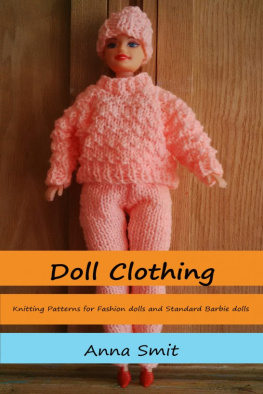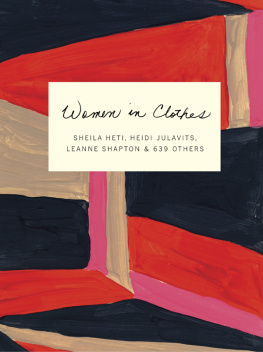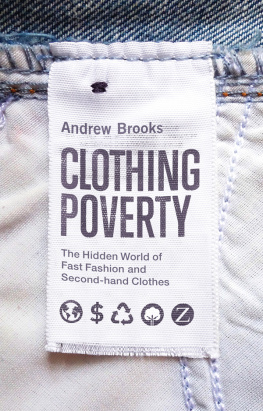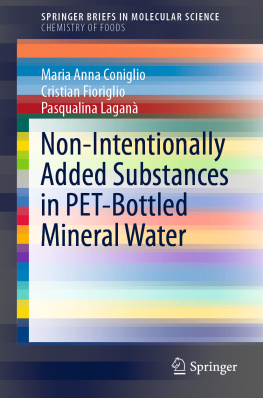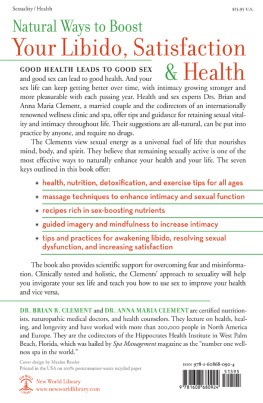KILLER
CLOTHES
Anna Maria Clement , PhD, NMD, LN
and Brian R. Clement , PhD, NMD, LN
Co-Directors, The Hippocrates Health Institute
2011 Brian R. Clement and Anna Maria Clement
Cover design: Jim Scattaregia
Interior design: Jim Scattaregia
All rights reserved. No portion of this book may be reproduced by any means whatsoever, except for brief quotations in reviews, without written permission from the publisher.
Hippocrates Publications, an imprint of Book Publishing Company
P.O. Box 99
Summertown, TN 38483
888-260-8458
www.bookpubco.com
ISBN 13: 978-1-57067-263-7
Printed in the United States
17 16 15 14 13 12 11 9 8 7 6 5 4 3 2 1
Library of Congress Cataloging-in-Publication Data
Clement, Anna Maria.
Killer clothes! : how seemingly innocent clothing choices endanger your health-- and how to protect yourself! / Anna Maria Clement, and Brian R. Clement.
p. cm.
Includes bibliographical references and index.
ISBN 978-1-57067-263-7
1. Textile fibers, Synthetic--Health aspects. 2. Environmental toxicology. I. Clement, Brian R., 1951- II. Title.
RA579.C54 2010
615.902--dc22
2010051721
Printed on recycled paper
Book Publishing Company is a member of Green Press Initiative. We chose to print this title on paper with 100% post consumer recycled content, processed without chlorine, which saved the following natural resources:
| 53 trees 1,460 pounds of solid waste 24,050 gallons of water 4,994 pounds of greenhouse gases 17 million BTU of energy | |
For more information on Green Press Initiative, visit www.greenpressinitiative.org. Environmental impact estimates were made using the Environmental Defense Fund Paper Calculator. For more information visit www.papercalculator.org.
Contents
INTRODUCTION:
Why the Emperor Wears No Clothes
As a young girl growing up in Sweden, I (Anna Maria) often heard a Scandinavian folk tale about two swindlers pretending to be weavers who convinced an emperor to purchase clothes made from a material of such high quality that they were invisible to any man who was unfit for his office or unpardonably stupid. Though the emperor realized that he couldnt see his new clothes, he refused to admit this to anyone out of fear he would be considered stupid or unfit to rule. The emperors attendants and subjects similarly played along and pretended they could see the clothes.
When the emperor wore his new clothes in a public procession, it fell to a little child to exclaim, He has nothing on at all. This innocent observation broke the spell so that everyone in the kingdom could admit to themselves and to each other that the reported clothes were nothing but a delusion.
This parable, The Emperors New Suit, by nineteenth century author Hans Christian Andersen, should hold new levels of meaning for us today. Pride, vanity, and stubborn denial, all on display in this story, also characterize our real-life clothing choices. Our Western cultures refusal to recognize an uncomfortable reality about the clothes we wear carries with it documented threats to personal health and environmental well-being.
Synthetic-fiber clothing is worn with an illusion of safety but hides invisible chemical and other dangers that clothing manufacturers and much of the worlds health-care industry ignores, or attempts to rationalize away. The emperor that rules most wardrobe choices today is fashion. This emperor is worshipped at an economic altar on which considerations of health and safety have largely been sacrificed.
Only in recent times have humans faced a fashion versus safety dilemma. Ornamenting the human body, whether with paint or tattoos or clothing, seems to have always been our natural impulse, but it was usually a secondary consideration to comfort and protection from the elements. Humankinds earliest clothing may have consisted of leaves and grass matted together and draped around the body, followed later by the use of animal hides to provide protection from sunlight, heat, cold, and the other elements of nature. Some of the earliest sewing needles made from ivory and bone have been carbon-dated to about 30,000 BC by archeologists, so we know that for much of human history the production of clothing from animal and plant sources was labor intensive and time consuming.
All of that changed dramatically with the Industrial Revolution of the late eighteenth and early nineteenth centuries, a period in which the textile industry was mechanized so that the mass production of clothing became both possible and profitable. Natural fibers such as cotton, flax, wool, and silk remained the mainstays of this industry until the petrochemical revolution of the twentieth century resulted in the creation of synthetic fibers in chemical laboratories.
Perhaps the most restrictive and unsafe item of clothing introduced in the name of fashion during the nineteenth (or any other) century was the corset. It squeezed womens bodies and crushed their internal organs, even displacing their ribs, until women could hardly breathe or move without experiencing pain. These virtual straitjackets were worn because many women chose to believe these garments made the feminine form more shapely and desirable to men.
There were some notable dissenters to the corset fad and the overall Victorian infatuation with restrictive clothing. A late nineteenth century British group called the Rational Dress Societywhose membership included Mrs. Oscar Wilde, wife of the satirist and writer Oscar Wildecampaigned against corsets and tight clothing, and advocated the adoption of a style of dress based upon considerations of health.
When it was founded in 1881, the group issued a position statement that could still be used today as a guideline for how to choose safe clothing: The Rational Dress Society protests against the introduction of any fashion in dress that either deforms the figure, impedes the movements of the body, or in any way tends to injure the health.
Synthetics Displace Natural Fibers
In virtually all areas of life during the twentieth century, synthetics replaced naturally derived consumer products. Nowhere, with the possible exception of cosmetics and personal care products, was this trend more pronounced than in clothing and fabrics manufacturing.
Rayon, introduced in 1924, was the first artificial textile fiber, though variations of this wood-based compound, including cellulose acetate, had been in use since the previous century. But the first truly synthetic fiber was nylonits petro-molecule source being toluenewhose introduction in 1939 made the mass production of parachutes for use in World War II a less expensive alternative to silk. In that same year, vinyon, a polyvinyl chloride, was created to bind non-woven fabrics. DuPont chemist Wallace Hume Carothers, generally credited as the inventor of nylon, also probably deserves the title of father of the synthetic textile industry.



